1991 Acura Integra Gs Engine Family Mhn18v5fwf9 Powertrain Control Module
| Honda Integra | |
|---|---|
 1993–1997 Honda Integra GSi (DC2) | |
| Overview | |
| Manufacturer | Honda |
| Besides called | Honda Quint Integra (Japan, 1985–1989) Honda Civic (Red china, 2021–present) Acura Integra (1985–2001, 2022) Acura RSX (2002–2006) Rover 416i (1985–1989) |
| Production | 1985–2006 2021–nowadays (Chinese-marketplace Integra) 2022 (North American-market Integra, to commence) |
| Model years | 1986–2006 2023 |
| Assembly | Japan: Suzuka, Mie (Suzuka Plant, 1985–2006) China: Guangzhou (Guangqi Honda, 2021–present) United states: Marysville, Ohio (Marysville Machine Plant, 2022) |
| Body and chassis | |
| Class | Compact car (C) |
| Body fashion | 3-door liftback coupé (1985–2006) 4-door sedan (1985–1989, 2021–present) iv-door pillared hardtop sedan (1989–2001) 5-door liftback (1985–1989, 2022)[1] |
| Layout | Front-engine, front-wheel bulldoze Front end-engine, four-wheel drive |
| Chronology | |
| Predecessor | Honda Quint Acura ILX (for North American 2022 model) |
| Successor | Acura EL (Canada, for third-generation sedan) Acura ILX (United States and Canada, for tertiary-generation sedan) Honda Civic Coupé (for DC5 model) Honda Civic Type R (for Blazon R model) Honda Fit Aria (for Integra SJ) |
The Honda Integra (Japanese: ホンダ・インテグラ, Hepburn: Honda Integura ), marketed in North America as the Acura Integra, is an automobile produced past the Japanese motorcar manufacturer Honda from 1985 until 2006, and and then since 2021. It succeeded the Quint as a more luxurious and sport-oriented derivative of the Civic. The Integra was one of the launch models for Acura in the U.s. in 1986 alongside Acura Legend.[2] Throughout its life, the Integra was highly regarded for its handling and operation. The 1995–2001 DC2 Integra Type R is widely regarded every bit 1 of the all-time front-wheel-drive cars of all time.[3] [4] [5] [vi] [7] [eight] [9] [10]
Machine and Commuter magazine named the Integra to its almanac Ten All-time listing 6 times: in 1987, 1988, and 1994 through 1997. The GS-R model was chosen out specifically in 1994 and 1995. It fabricated a return on the Ten Best list as the Acura RSX, in 2002 and 2003.
The Integra nameplate was revived in 2021 after a 16-yr hiatus.[11] [12]
Start generation (1985) [edit]
| Series AV, DA1-DA4 | |
|---|---|
 | |
| Overview | |
| As well called | Honda Quint Integra Acura Integra Rover 416i |
| Production | 1985–1989 |
| Model years | 1986–1989 |
| Associates | Japan: Suzuka, Mie (Suzuka Plant) |
| Body and chassis | |
| Torso style | 3-door liftback coupé 4-door sedan 5-door liftback |
| Related | Honda Concerto |
| Powertrain | |
| Engine | i.five L EW5 (DA2) 1.six 50 ZC (DA1 & DA3) 1.6 50 D16A1 (DA1 & DA3) 1.5 L D15A1 (DA4) |
| Transmission | five-speed manual iv-speed automated |
| Dimensions | |
| Wheelbase | iii-door: 2,450 mm (96.5 in) 4/v-door: two,520 mm (99.two in) |
| Length | 3-door: 4,285 mm (168.vii in) 5-door: 4,355 mm (171.five in) 4-door: 4,380 mm (172.four in) |
| Width | 1,665 mm (65.6 in) |
| Superlative | 1,290 mm (l.8 in) |
This vehicle debuted in Japan in February 1985 as the Honda Quint Integra, available merely at Honda's Japanese dealership sales aqueduct Honda Verno before going on sale a year after in Due north America as function of the then-new luxury Acura lineup. The three-door liftback was the only model available originally, with a five-door arriving in October 1985. The four-door saloon bodystyle became available in Nippon in the autumn of 1986.[13] Only the liftback versions were sold in the U.S. A 1.6 L DOHC sixteen-valve four-cylinder engine powered most versions. The engine was the vehicle'due south most publicized feature, as DOHC, multi-valve engines were not commonplace in entry-level models at the time. In nigh European countries, only the five-door liftback was offered, as a replacement for the Honda Quint. Typically for European Integras, only the 1.5-liter 85 PS (63 kW; 84 hp) 4 Weber carburetors engine was available. The five-door liftback model was also sold in Commonwealth of australia rebadged as the Rover 416i. Except for in Great britain, Honda did not offering the more than powerful one.6 DOHC fuel injection engine (in the Britain known as the Integra EX16) in Europe. The ZC engine was also shared with the Honda Concerto, which was sold at newly established Japanese dealership sales channel called Honda Clio, which sold luxury oriented products like the Honda Legend.

Honda Integra (DA3) SX16 3-door sport coupe (Australia)

Acura Integra five-door (US)
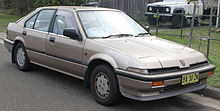
In Japan, while the VX- and RX-trimmed four-door (DA2)[14] used the 1.5 L EW5 engine, all other model and trim combinations offered only the DOHC ZC engine, with a carburetor on GS, ZS, and LS trim packages, and PGM-FI on the acme level GSi three- and five-door, and the RSi three-door trim package. Vehicles installed with a carburetor earned fifteen.4 km/Fifty (44 mpg‑imp; 36 mpg‑Us) in Japanese Government emissions tests and 115 PS (84.6 kW; 113.4 bhp), and 26 km/L (73 mpg‑imp; 61 mpg‑The states) at consistent speeds above 60 km/h (37.three mph). Vehicles with PGM-FI earned 14.4 km/L (41 mpg‑imp; 34 mpg‑United states of america) in Japanese Government emissions tests with 135 PS (99.3 kW; 133.2 bhp), and 24.5 km/L (69 mpg‑imp; 58 mpg‑US) above threescore km/h (37.3 mph).[15] In Japan, the Integra took the entry level marketing position at Honda Verno, beneath the sporty Prelude and larger, luxury focused Vigor.
Compared to the US, the European Integra was aimed downmarket and generally lacked equipment, with neither trim level (LX or EX) offering painted bumpers, primal locking, power windows, nor ac, even though a minor number of fully equipped, left-hand drive fuel-injected Integras were sold in holland. The Integra EX16 did offering a sunroof, painted bumpers, a rear spoiler and Hi-Fi stereo equipment, but neither electric windows, central locking nor air workout were bachelor. This was considered as a drawback to its European competitors such as the Peugeot 309 i.6 injection and the Renault 11 Turbo, that all could exist equipped with comprehensive, albeit expensive, equipment. The first Integra never became every bit pop in Europe every bit it did in the US, merely was praised by nearly motor magazines for its styling and overall road performance. The styling reflected the popularity of Honda'southward operation coupe, the Honda Verno sports coupe companion Honda Prelude, with the Integra offering a coupe for added cargo accommodation, and a slightly smaller advent to the larger Honda Vigor. Largely unencumbered by emissions regulations, British marketplace cars produce 85 PS (63 kW) in the 1.5 and 125 PS (92 kW) in the 1.half-dozen-liter EX16.[xvi]
Being designed every bit the successor of the Honda Quint, the Integra is closely related to the Borough, although it featured a modest listing of central upgrades over its smaller stablemate to help merit a price increase over the CRX Si, which was otherwise the sportiest subcompact vehicle beingness offered by Honda Verno; enlarged 4-wheel disc brakes replaced the minor front-disc/rear-drum setup used by the Civic and CRX, suspension calibration was re-worked, better tires were used and a 113-hp DOHC fuel-injected xvi-valve engine was used in identify of the SOHC unit from the CRX Si. But like the Prelude and the Vigor of that menstruum, the Integra featured sleek, sporty pop-up headlights, like its Japanese dealership Honda Verno stablemates, with the CRX adopting semi-concealed doors over the headlights. Nearly 228,000 units were sold during the 4-year run of the start-generation model, most of them in the United States.
The offset generation Acura Integras actually came with two dissimilar engines. Although they shared the same engine code (D16A1), there were a few differences. The engine differed in the years 1986 to 1987 and 1988 to 1989. The 2 engines are commonly called the "Browntop" and "Blacktop" due to the color of their valve covers. The "browntop" came in 1986 and 1987 Integras while the "blacktop" came in 1988 and 1989 models. The improvements in the "blacktop" engine included lighter rods, domed pistons for slightly higher compression, and an electrical advance distributor (the "browntop" came with a vacuum accelerate distributor). The overall gain in performance was near 5 hp (three.7 kW) for 118 hp (88.0 kW).
The 1988 and 1989 Integras likewise got a minor facelift, featuring slightly reshaped indicator lights, an improved climate control organization and an update of the instrument clocks. In Europe, the Integra five-door Liftback was discontinued in Oct 1989 following the launch of the Rover-based Honda Concerto.
This was the only generation to offer three-, iv-, and 5-door models. Production of the 5-door liftback ceased in 1988.[17]
2d generation (1989) [edit]
| Series DA5-DA9, DB1-DB2 | |
|---|---|
 | |
| Overview | |
| Production | 1989–1993 |
| Model years | 1990–1993 |
| Associates | Nippon: Suzuka, Mie (Suzuka Plant) |
| Body and chassis | |
| Body style | three-door liftback coupé 4-door pillared hardtop sedan |
| Related | Honda Civic Honda Domani Rover 400 Rover 200 |
| Powertrain | |
| Engine | i.half-dozen L ZC (DA5 & DA7) one.6 L B16A (DA6 & DA8) i.eight Fifty B18A1 (DA9 & DB1) 1.vii L B17A1 (DB2) |
| Transmission | 5-speed manual 4-speed automatic |
| Dimensions | |
| Wheelbase | Coupe: 2,550 mm (100.four in) Sedan: two,600 mm (102.iv in) |
| Length | Coupe: 4,390 mm (172.8 in) Sedan: 4,485 mm (176.6 in) |
| Width | 1990: 1,712 mm (67.iv in) 1991–92: 1,715 mm (67.v in) (Japan only) 1,695 mm (66.7 in) |
| Summit | 1990 Coupe: 1,325 mm (52.2 in) 1990 Sedan: 1,340 mm (52.eight in) 1991–92 Hatchback: one,270 mm (fifty.0 in) 1991–93 Sedan: 1,285 mm (50.6 in) |
| Curb weight | i,160–i,202 kg (2,557–2,650 lb) |

Liftback

Sedan (modified)

Integra DA5 liftback
The 2d generation Integra was introduced in April 1989, featuring the first VTEC engine ever manufactured by Honda (the B16A). For North America's GS-R only, the B17A1 engine is a 1.7-liter DOHC VTEC naturally aspirated engine with a specific power output of 160 PS (118 kW; 158 hp). VTEC engagement is at v,500 rpm on the B16A engine, redline for the XSi is 8,200 rpm. All Japanese models remained exclusive to Honda Japanese dealership network chosen Honda Verno.
At that place were two variants of the meridian DOHC VTEC model, the RSi, and the XSi. The RSi was the base model with a lighter weight thank you to wind-up windows, no rear spoiler and few options. Early RSi models too featured the S1 gearbox with slightly closer gear ratios than the Y1 fitted to the XSi. The XSi was the fully optioned variant with climate control and optional sunroof and ABS. The XSi had a 0–100 km/h (62 mph) time of seven.2 seconds and tin consummate a standing quarter mile in 15.1 seconds. This summit spec DOHC VTEC model was complemented past more than docile models that used dual-carburetor or PGM-Fi versions of the versatile ZC engine only in the more compact SOHC configuration. Similarly there were base of operations and full options variants of these SOHC engine Integras coded RX/RXi and ZX/ZXi respectively. All vehicles sold in Japan had their width dimensions slightly reduced so as to be in compliance with Japanese government regulations apropos exterior dimensions and then that the car would be officially recognized as a "compact" and not incur yearly taxes for being wider. In October 1991, the range received a mild facelift. At the same fourth dimension, a one.eight-liter version of the four-door hardtop was made available in Japan. Chosen the ESi, it offered 140 PS (103 kW; 138 hp) at half-dozen,300 rpm and was only bachelor in conjunction with a 4-speed automatic transmission.[18] At the same fourth dimension, the VTEC was upgraded and now had 170 PS (125 kW; 168 hp).
This generation saw the discontinuation of the 5-door liftback, and the first availability of a iv-door sedan outside Japan. The new hardtop bodystyle reflected a popular trend in Japan of offer an entry level sedan, such as the Borough-based platform the Integra used, in a reduced height 4-door hardtop. The Integra sedan saw contest from the similarly sized Toyota Corolla Ceres, the Toyota Sprinter Marino, the Nissan Presea, and the Mazda Lantis. The sedan was only styled to expect like a hardtop. The vehicle retained the B-pillar, while the doors were constructed without window frames. This styling carried over to the third generation sedan, and shared visual similarities to the Honda Verno larger companion, the Honda Vigor.
The so-Emperor of Japan, Akihito, until he discontinued driving shortly after his 85th birthday, maintained a gray 1991 Integra sedan with the ane.6 50 engine, and regularly drove within the boundaries of the Imperial Palace.[19]
Due north American marketplace [edit]
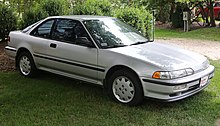
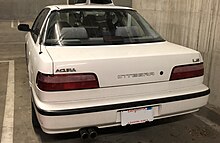
In North America, the Integra was sold under the Acura nameplate. Acura offered three trim levels (RS, LS and GS) for 1990 and 1991 model years and added a 4th trim level (GS-R) beginning in May 1992. Model choices consisted of a iii-door liftback and a new iv-door sedan. All trim levels were available with a five-speed transmission or 4-speed automatic manual except for the GS-R which was only offered in a 5-speed manual with shorter gearing than other trim levels.
GS-R [edit]
For the 1992 and 1993 model years, Acura offered a GS-R model. The GS-R liftback came only with a v-speed manual transmission and 1.vii-liter B17A1 4-cylinder DOHC VTEC engine with 160 hp (119 kW). The GS-R model came with a rear spoiler and 195/60/VR14 tires and blend wheels.
The GS-R model is rare with less than v,000 of the 1992–1993 model years Acura Integra GS-R were produced for North America, this is confirmed by the vehicle identification number sequence of these cars. Using this information, the production numbers of the GS-R via vehicle history reports are determined.[xx] The Due north American production breakup was reported as follows:[20]
| Land | MY 1992 | MY 1993 | Total |
|---|---|---|---|
| U.s.a. | iii,118 | 850 | 3,968 |
| Canada | 602 | 255 | 857 |
| Total | 3,720 | ane,105 | 4,825 |
Third generation (1993) [edit]
| Series DB6-DB9, DC1-DC2, DC4 | |
|---|---|
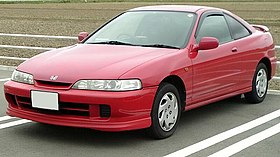 | |
| Overview | |
| Production | 1993–2001 |
| Model years | 1994–2001 |
| Associates | Japan: Suzuka, Mie (Suzuka Plant) |
| Torso and chassis | |
| Torso style | three-door liftback coupé 4-door pillared hardtop sedan |
| Layout | front end-wheel drive all-wheel bulldoze (DB9 just) |
| Related | Honda Borough Honda Accordance Honda Prelude |
| Powertrain | |
| Engine | 1.vi L SOHC ZC (DB6, DB9, DC1) 1.8 Fifty DOHC B18B (DB7, DC4) 1.8 Fifty DOHC VTEC B18C (DB8, DC2) |
| Transmission | v-speed close ratio manual 4-speed automatic (with 2,400 rpm torque converter) |
| Dimensions | |
| Wheelbase | 2,570 mm (101.two in) (Liftback) ii,620 mm (103.i in) (Sedan) |
| Length | 4,380 mm (172.4 in) (Liftback) 4,395 mm (173.0 in) (Liftback, AU/NZ) 4,425 mm (174.2 in) ('00–'01 Liftback GS-R) 4,525 mm (178.1 in) (Sedan) |
| Width | 1,695 mm (66.7 in) (all Japan models, '94–'96 Liftback international) 1,710 mm (67.3 in) ('98–'01 Liftback international) |
| Height | 1,290 mm (50.8 in) ('94–'95 Liftback) 1,335 mm (52.6 in) ('96–'01 Liftback) one,320 mm (52.0 in) ('98–'99 TypeR) 1,325 mm (52.two in) ('94–'96 Sedan) 1,370 mm (53.9 in) ('96–'01 Sedan) |
| Curb weight | 1,105 kg (2,436 lb) (Liftback, Manual) 1,125 kg (2,480 lb) (Liftback, Auto, AU/NZ) 1,175 kg (two,590 lb) (Liftback, Motorcar) 1,177 kg (2,595 lb) |
Honda debuted the 3rd generation model in 1993 in Japan at Honda Verno locations. It had an unusual four headlight front end design which was dubbed "spider eyes" past some enthusiasts.[ citation needed ] Standard power (in Japan) from the B18B engine increased to 142 hp (106 kW; 144 PS). In the U.Southward., the B18B1 produced slightly less power due to a lower pinch ratio (emissions related).The tiptop model was known in Japan as "Si", and it was powered past a B18C engine with a power of 176 hp (131 kW; 178 PS) VTEC. The 4 headlight front end design, or "spider heart" headlights, proved controversial in Japan, so all JDM Integras were given a minor facelift in 1995 with more conventional elongated flat headlights and a revised front bumper. The tiptop model was relabeled as the Integra SiR.
This generation Integra was generally not bachelor in Europe, although some markets such as Greece did receive this model. Those cars were fitted with a 104 hp (78 kW; 105 PS) version of the 1590 cc ZC engine.[21] From 1998 onward, non-JDM Integras (including Type R models) received a facelift to the front bumper which moved the embossed "INTEGRA" label to beneath the left headlights, eliminated the horizontal strut beyond the radiator grille and reshaped the headlight housing, turn signal housing and lower bumper.
Dealer-installed options for the third generation Integra included: security system, 15" alloy wheels, trunk mat, splash guards, fog lights, rear wing spoiler, sunroof (liftback only), CD changer, leather seats, leather shift knob and leather steering wheel.
USDM trim levels were as follows:
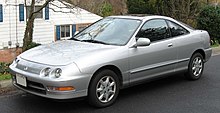
RS: Regular Sport was bachelor in both liftback and sedan. In that location was no sedan available in 1998. Model dropped in 1999. Equipped with the B18B1 DOHC engine putting out 140 hp (104 kW; 142 PS) and 127 lb⋅ft (172 N⋅m) of torque. In 1997, ability ratings dropped to 138 hp (103 kW; 140 PS) and 124 lb⋅ft (168 N⋅m) of torque due to U.S. emissions regulations. Standard features were a cassette player, rear window defroster, and tilt steering wheel. Cassette actor replaced with CD player in 1997. The RS models also as Type Rs did non come with sunroofs equally an option, while the LS, SE, GS, and GS-R sub-models did.
LS: Luxury Sport, was available in both liftback and sedan a leather wrapped steering bicycle and shift knob.[22]
SE: Special Edition, was available in both liftback and sedan starting from 1995. The trim was only available in 1995 and 1996 model years until they were inverse to be named the GS in 1997. From the LS, information technology added leather seats, alloy wheels on all years, and a rear wing spoiler (optional).[22]
GS: One thousand Sport, was available in both liftback and sedan starting from 1997. Aforementioned standard features every bit the SE. Including a rear spoiler.[22]
GS-R: Grand Sport Racing, was available in both liftback and sedan. Equipped with the 1.eight liter DOHC VTEC (B18C1) engine outputting 170 hp (127 kW; 172 PS) and 128 lb⋅ft (174 N⋅k) of torque. It came equipped with a rear spoiler, 6-speaker stereo and 195/55/VR15 tires and alloy wheels. An automatic transmission is an pick in certain markets for this auto.[22]
Integra Blazon R [edit]

1995–1998 JDM Honda Integra Type R

1995–1998 JDM Honda Integra Type R rear
In 1995, Honda introduced the Integra Blazon R to the Japanese domestic market.[23] The Type R came standard with a 197 hp (147 kW; 200 PS) (figure may vary in different countries, 195 hp (145 kW; 198 PS) USDM, 187 hp (139 kW; 190 PS) UKDM) factory-tuned variant of the B18C engine. Equipped with a close ratio 5-speed manual transmission and a Helical LSD, the DC2 Integra Type R had significantly improved performance and treatment relative to the GS-R/Si/SiR-G Integra.
These were the effect of extensive changes, including a strengthened chassis with extra spot welds and thicker metal effectually the rear shock towers and lower subframe, weight reduction (reduced sound insulation, 10% thinner windscreen, lighter wheels), more power, rev limiter set at 8,600 rpm JDM (8,500 rpm USDM, 8,700 rpm UKDM), manus built engine featuring hand-polished and ported intake ports, high compression pistons, undercut valves and revised intake and exhaust systems, and interruption upgrades. The effect was a capable sports liftback which was acclaimed by motoring journalists worldwide. The JDM version was significantly lighter than the SiR Integra (The 96–97 spec model could delete the air numberless, A/C, rear wiper, radio, center panel, clock, P/S and ABS), However, there is but a 33 lb (fifteen kg) net weight difference between the USDM Integra Type R and the Integra GS-R because the extra metal and cantankerous bracing in the Type R negate much of the 98 lb of weight reductions. The DC2 Type R was the but Type R ever sold in North America with the Acura badge. For the European, Australian and New Zealand marketplace the DC2 was sold as a Honda with the iv headlight forepart design.
The JDM DC2 Type R received significant upgrades in 1998 and is known as the '98 Spec R. Some of the principal changes were a redesigned rear bumper, sixteen-inch bicycle with 215/45R16 tires, five-lug nut wheel hubs and bigger brakes. Gear ratios for the terminal drive were higher, making 1st to 3rd gears closer, while 4th and fifth were longer to maintain the '96 Spec cruising comfort. The engine ability remained the same, merely use of a new four–one long tube header brought torque lower downward to half-dozen,200 rpm.
A final revision of the JDM DC2 Type R known as the '00 Spec R included a revised intake camshaft, and more finely balanced drive shafts. A last trim version offered in mid-2000 onwards for the JDM market (known as the "Blazon Rx") came manufactory fitted with motorized folding mirrors, dashboard clock, blue-hue carbon trim interiors, and an audio system as part of the standard bundle. it too included a hash pocket in the heart console.
- Edmund's Insideline tested a 12-year-old stock Type R: 0–60 mph (97 km/h) in 6.viii seconds, ane/iv mile in 14.9 seconds @ 95.2 mph.
- Motor Trend clocked the Type R at: 0–lx mph (97 km/h) in six.two seconds, i/four mile in 14.8 @ 96.3 mph.
- Sport Compact Motorcar clocked the Blazon R at: 0–60 mph (97 km/h) in 6.1 seconds, 1/4 mile in 14.5 @ 96 mph.
In Japan, the Integra is revered every bit one of the best sports cars of the '90s. On Japanese auto review show "Best Motoring" the Integra Blazon R punched well above its weight competing with fastest 4WD Turbo cars of the fourth dimension, the Nissan Skyline GTR[24] and the Subaru WRX STI.[25]
It has been acclaimed by motoring journalists worldwide, including Evo magazine, which named the Type R 'the greatest front-wheel-drive performance car ever', and TheAutoChannel.com, which similarly called it 'the best handling front end-bicycle bulldoze automobile ever'.[26]
4-bike Drive Integra (DB9) [edit]
The third generation besides saw the production of a iv-bike drive choice. Available but in the four-door sedan, the ZXi4WD[27] (93–95) and Xi4WD[28] (95-00) had i.6L SOHC ZC engines coupled to a version of Honda's Real Time 4WD.
Integra SJ (EK3) [edit]



The Integra SJ (standing for "Sedan Joyful") was a rebadged Borough Ferio, (a Honda Primo production) with modified headlamps and grille similar to the Orthia's and slightly larger rear lights that were also utilized on the Japanese market Civic LEV sedan. The Integra SJ was sold in Japan at Honda Verno dealerships. It originated from the Honda Domani, another derivative of this vehicle sold at Honda Clio locations. It was made from 1996 to 2001, and used the 1493 cc D15B engine. Honda's press fabric of the time indicated that the SJ was intended to provide a "formal sedan" for the Integra range; another reason may accept been to sell Ferios using a more sporting model name at Honda Verno dealerships in Japan, as was the case with the Nissan Laurel Spirit. In Thailand, the Integra SJ was sold as the Isuzu Vertex, the last rider motorcar ever for that market. (This followed Isuzu's practise of selling Honda models as Isuzus which started with the Gemini; with Honda also selling Isuzu's sport utility vehicles in Nippon and Northward America (some equally Acuras in the latter market), and pickup trucks in Thailand.)
Theft in the Us [edit]
In 2004, CCC Information Services named the 1999 Integra as the about stolen car in the United States, with the 1998 model year of the machine listed as the third-most stolen model for that twelvemonth.[29] In 2014, LoJack named the Integra equally the 6th most stolen auto among vehicles equipped with their motorcar tracking service.[30]
Fourth generation (2001) [edit]
| Series DC5 | |
|---|---|
 | |
| Overview | |
| Also called | Acura RSX |
| Production | 2001–2006 |
| Model years | 2002–2006 |
| Assembly | Nihon: Suzuka, Mie (Suzuka Found) |
| Body and chassis | |
| Trunk style | three-door liftback coupé |
| Powertrain | |
| Engine | 2.0 L K20A, K20A2 (02-04), K20A3, K20Z1 (05-06) |
| Transmission | five-speed transmission 6-speed manual 5-speed automatic |
| Dimensions | |
| Wheelbase | 2,570 mm (101.two in) |
| Length | 4,397 mm (173.ane in) |
| Width | one,724 mm (67.9 in) |
| Summit | 2002–04: ane,400 mm (55.1 in) 2005–06: ane,394 mm (54.9 in) |
| Adjourn weight | 2,790 lb (ane,266 kg) |
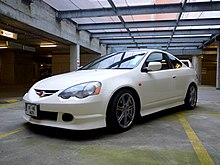

Honda Integra Special Edition coupe
The fourth generation Integra was introduced in Japan on April 13, 2001 and produced from July 2001 to August 2006. For N America (The states and Canada), it was introduced as the Acura RSX in accordance with Acura's new alphabetical naming scheme. It besides had an entirely new engine, the K-series. The Integra came in two models in the United states of america, the RSX and the RSX Type-Southward boasting the K20A2 engine from 2002 to 2004, while the 2005 and 2006 RSX-South came with a K20Z1. The RSX was sold equally a Honda Integra in Japan and Australia, markets where Acura did not exist.
In March 2006, Honda announced that the Integra would be discontinued in June after its concluding 300 cars were sold, due to the shrinkage of the coupe market. The reaction of the consumers towards the discontinuation, yet, forced Honda to extend production until July 2006 and produce 150 more Integras. The Acura RSX was discontinued also, as the RSX did not fit within the confines of Acura's re-structured market strategy. This left the Acura TSX equally Acura'due south entry-level vehicle. Too, the introduction of the similarly powerful and less expensive 2006 model-year Honda Borough Si was there to fill in the gap left by the RSX.
The DC5 Type R (Japanese market just) comes standard with a K20A 220 hp (164 kW) 2.0 L DOHC i-VTEC four-cylinder engine. The "i" in i-VTEC stands for intelligent VTEC, which employs VTC (Variable Timing Control) to accelerate or retard the intake cam timing inside a 50 degree range. The Integra Blazon R comes equipped with Recaro seats, 4-piston Brembo front brakes, a shut ratio six-speed transmission transmission, a limited-slip differential, variable back-pressure exhaust system, and a stiffer suspension.
Fifth generation (2022) [edit]
China [edit]

2021 Honda Integra (China)
The China-exclusive fifth-generation Honda Integra sedan (Chinese: 型格; pinyin: Xínggé ) was introduced in September 2021 as the twin model of the eleventh-generation Civic sedan, produced by Guangqi Honda.[31] [32] [33] [34]
Northward America [edit]
| Fifth generation North America | |
|---|---|
| Overview | |
| Production | 2022 (to embark) |
| Model years | 2023 |
| Assembly | The states: Marysville, Ohio (Marysville Auto Plant) |
| Trunk and chassis | |
| Body manner | 5-door liftback |
| Layout | Front-engine, front-bicycle-drive |
| Related | Honda Civic (eleventh generation) |
| Powertrain | |
| Engine |
|
| Transmission |
|
| Dimensions | |
| Wheelbase | 107.7 in (ii,736 mm) |
| Chronology | |
| Predecessor |
|
The Acura Integra will be reintroduced in North America in the first quarter of 2022 for the 2023 model year as a v-door liftback to replace the Acura ILX. It is also built on the same platform every bit the eleventh-generation Civic.[35] Powertrain options include a 1.five-liter turbocharged 4-cylinder engine mated to a half-dozen-speed transmission transmission.[11] [36] [37] [38] Dissimilar the previous Japan-imported models, it will be produced in the U.s.a. at the Marysville Motorcar Plant in Marysville, Ohio starting in 2022.[39]
Marketing [edit]
The Integra appeared in the Chiaki's Journey serial of Acura Type-Southward commercials.[twoscore]
Motorsport [edit]

The Integra and RSX take been popular in automobile racing.
In 1987 and 1988, the Integra won 2 consecutive IMSA International Sedan series manufacturers' championships, while Parker Johnstone won drivers' championship in the aforementioned years driving the Integra.[41]
In 1992, the Integra was used in Formula One as a prophylactic car at the Canadian Grand Prix.
Realtime Racing used the Integra Type R and later the RSX Type S to compete in the SCCA Globe Challenge Touring Car class, winning half-dozen consecutive titles from 1997 to 2002. The BTC-T version of the Integra was very successful in the British Touring Auto Title, winning 27 races and becoming the champion in 2005 and 2006, despite being only entered by privateer teams. The Integra also won the Asian Touring Car Series in 2003, 2004, 2009 and 2010.
Sales [edit]
| Calendar year | Us |
|---|---|
| 1986 | 27,807[42] |
| 1987 | 54,757[42] |
| 1988 | 57,468[42] |
| 1989 | 77,423[42] |
| 1990 | 83,559[42] |
| 1991 | 64,755[42] |
| 1992 | 55,174[42] |
| 1993 | 58,757[42] |
| 1994 | 67,426[42] |
| 1995 | 61,316[42] |
| 1996 | 46,966[42] |
| 1997 | 38,331[42] |
| 1998 | 34,904[42] |
| 1999 | 26,184[42] |
| 2000 | 25,975[42] |
| 2001 | xiii,376[42] |
| 2002 | 19[42] |
Run into besides [edit]
- BTC-T Honda Integra Type R
References [edit]
- ^ "New Acura Integra Teaser Confirms Sleek, Five-Door Sportback".
- ^ "Acura Owner Stories, Events & Articles | Acura Owners Site". Owners.acura.com. 3 January 2011. Retrieved 22 February 2017.
- ^ Knapman, Chris (2018-07-20). "Honda Integra Type R: the greatest front-wheel-drive motorcar ever?". The Telegraph. ISSN 0307-1235. Archived from the original on 2022-01-12. Retrieved 2018-ten-13 .
- ^ "Is The Acura Integra The Best FWD Car Of All Fourth dimension?". Motor1.com . Retrieved 2018-ten-13 .
- ^ "The Magic of the Integra Blazon R". Road & Track. 2017-11-22. Retrieved 2018-10-thirteen .
- ^ "The Acura Integra Was The Sports Automobile To Have In The Tardily '90s". CarBuzz . Retrieved 2018-x-13 .
- ^ Cironi, Davide (2015-11-02). "Why Is The Integra Type-R So Perfect From The Commuter'due south Seat?". Petrolicious . Retrieved 2018-ten-xiii .
- ^ Clavey, William. "How The Acura Integra Type R Makes Modernistic Sport Meaty Cars Expect Weak". Jalopnik . Retrieved 2018-ten-thirteen .
- ^ "Honda Integra: Honda Integra Type-R". Evo . Retrieved 2018-10-13 .
- ^ "This 1997 Acura Integra Type R is the Holy Grail for 1990s youth". Retrieved 2018-ten-13 .
- ^ a b "A Legend Returns: New Acura Integra Coming for a New Generation" (Printing release). Monterey, California: Honda. Baronial 13, 2021. Retrieved Baronial 13, 2021.
- ^ https://paultan.org/2021/09/30/2022-honda-integra-revealed-for-china/
- ^ Büschi, Hans-Ulrich, ed. (3 March 1988). Automobil Revue 1988 (in German and French). Vol. 83. Berne, Switzerland: Hallwag AG. p. 316. ISBNiii-444-00469-9.
- ^ インテグラ(1989年4月終了モデル) [Integra (end of April 1989 model)]. Nihon: Honda. Retrieved 9 February 2017.
- ^ Japanese sales brochure for the Integra[ when? ]
- ^ Honda Integra (brochure), Honda UK, 1988, p. 18
- ^ 今まで販売したクルマ|インテグラ [Cars sold until now | Integra]. Japan: Honda. Retrieved 9 February 2017.
- ^ 自動車ガイドブック [Japanese Motor Vehicles Guide Book 1991~'92] (in Japanese). Vol. 38. Japan: Nippon Automobile Manufacturers Association. 23 October 1991. p. 228. ISBNfour-915220-38-9.
- ^ Shima, Yasihiku (22 Nov 2013). "Imperial Family Lookout: Emperor Akihito is in the slow lane when driving". The Asahi Shimbun. Archived from the original on 26 March 2015.
- ^ a b "92–93 GSR product numbers". Generation 2 Integra Club . Retrieved 1 January 2015.
- ^ Honda Integra (brochure), Όμιλος Επιχειρήσεων Σαρακάκη (Saracakis Group), 1994, p. 4
- ^ a b c d "History of the Acura Integra". squad-integra.net. 21 March 2020.
- ^ "Honda|インテグラ(2001年6月終了モデル)". www.honda.co.jp . Retrieved 24 May 2019.
- ^ miroshi (2014-06-22), [ENG CC] FWD vs 4WD - Integra Type R DC2 200Hp vs Skyline R32 GT-R 280Hp HV24, archived from the original on 2021-12-12, retrieved 2018-x-xiii
- ^ no ahora porfavor (2008-11-17), Honda Integra Type-R vs Subaru Impreza WRX STi Vs Mitsubishi FTO Vs Honda Civic VTi.avi, archived from the original on 2021-12-12, retrieved 2018-x-13
- ^ "Acura Integra Blazon R New Car Review: Acura Integra Type R (1998) New Motorcar Prices for Acura Integra Type R". www.theautochannel.com . Retrieved 2018-10-thirteen .
- ^ Honda乥僀儞僥僌儔乮1995擭8寧廔椆儌僨儖乯. honda.co.jp.
- ^ Honda乥僀儞僥僌儔乮2000擭廔椆儌僨儖乯. honda.co.jp.
- ^ "Acura Integra tops most-stolen vehicle list". NBC News . Retrieved 2020-eleven-xxx .
- ^ Schmitz, Matt; Woodyard, Chris. "LoJack names its ten well-nigh stolen cars". USA Today . Retrieved 2020-eleven-30 .
- ^ https://paultan.org/2021/09/30/2022-honda-integra-revealed-for-people's republic of china/
- ^ "【图】思域姊妹车 曝广汽本田Integra申报信息_汽车之家".
- ^ "广汽本田Integra申报图曝光 搭载1.5T发动机_太平洋汽车网".
- ^ https://news.m.yiche.com/xinchexiaoxi/20210928/2115025192.html
- ^ Powell, Derek (2021-11-12). "2023 Acura Integra Prototype is the Improvement Kid". Car and Driver . Retrieved 2021-eleven-12 .
- ^ Anderson, Brad (Baronial 13, 2021). "Acura Is Reviving The Integra And Launching Information technology Side by side Year". Carscoops . Retrieved August xiii, 2021.
- ^ Chan, Mick (September 29, 2021). "2023 Honda Integra – teaser reveals four-door fastback". paultan.org . Retrieved September 29, 2021.
- ^ Priddle, Alisa (August thirteen, 2021). "The Acura Integra Is Coming Dorsum and "Volition Live Up to the Hype"". Motor Trend . Retrieved August xiii, 2021.
- ^ "New Acura Integra Prototype Makes Global Debut; Previews a Premium Sport Compact for a New Generation". 12 Nov 2021.
- ^ New Acura Anime Series Showcases Type S Performance Lineup
- ^ "Acura 25th Anniversary Timeline". Honda Newsroom. 2011-03-29. Retrieved 2019-12-08 .
- ^ a b c d e f thou h i j k 50 m n o p q "2015 Honda Digital FactBook" (PDF) (Press release). US: Honda. June 2015. p. 11. Archived from the original (PDF) on 5 September 2015. Retrieved 2 November 2016.
External links [edit]
- Honda Worldwide site
Source: https://en.wikipedia.org/wiki/Honda_Integra
0 Response to "1991 Acura Integra Gs Engine Family Mhn18v5fwf9 Powertrain Control Module"
Post a Comment